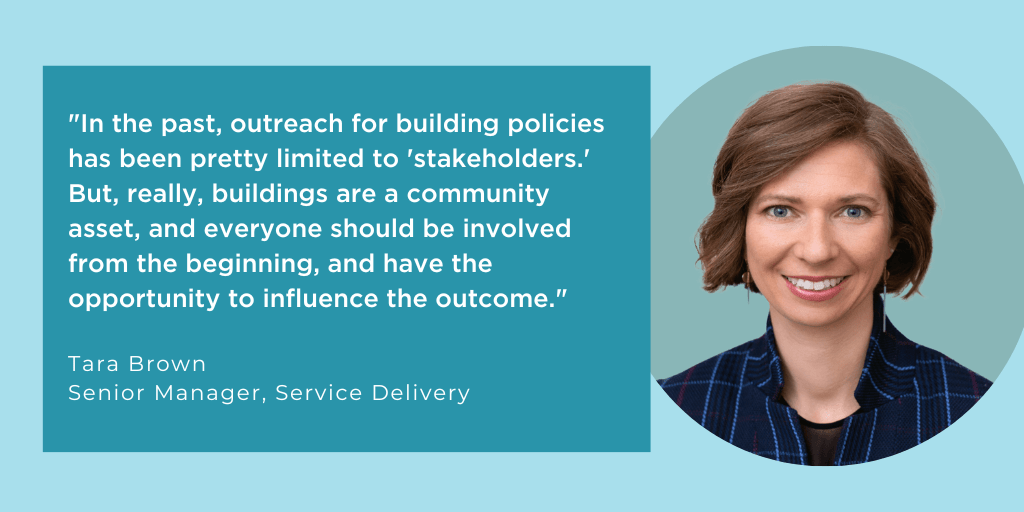President Biden’s announcement last January of the National Building Performance Standard (BPS) Coalition brought some much-needed attention to the critical role buildings play in making our climate and our communities better. But what exactly is the Coalition, and how does it work? IMT’s Tara Brown, Senior Manager for Service Delivery, and Rajiv Ravulapati, Senior Manager of Government Engagement, have been on the ground connecting with the Coalition members and offered their insights.
What is the National BPS Coalition?
Tara Brown & Rajiv Ravulapati: The Coalition is a voluntary commitment from about 40 cities, counties, and states to pass building performance policies and programs by April 22, 2024 — Earth Day. We, other building experts, and community leaders are working with these jurisdictions to try and make sure they do so in a way that models community-driven policymaking and implementation.
What is community-driven policymaking?
Tara : When we first started talking about the Coalition, what really excited me was scaling the concept of community-led policymaking. In the past, outreach for building policies has been pretty limited to “stakeholders,” defined mainly as building owners and industry professionals working with the city, and there has been a very limited period for public feedback at the end. But, really, buildings are a community asset, and everyone should be involved from the beginning, and have the opportunity to influence the outcome. In particular, we need to give more voice to residents from frontline communities — those that experience the most immediate and worst impacts of climate change and are most often communities of color, Indigenous, and low-income communities.
Rajiv: All policies should be community-led. The opportunity here is for Coalition members to really follow through on this, with support and resources that could make this successful. With the passage of the Inflation Reduction Act (IRA), there is a once-in-a-lifetime opportunity to really push this concept forward, while also meaningfully reducing carbon emissions. A BPS policy offers governments a lens on how to look closer at social priorities like resilience, housing affordability, and improving public health.
Tara: Agreed. And, in terms of carbon reductions, I’ll note that there is no way for these jurisdictions to hit their climate goals without addressing energy used in buildings. We have to be successful.

What has been your work on the National BPS Coalition?
Tara: I’ve been working as a liaison between jurisdictions, IMT, and the White House. My role has been to help local staff understand the power of Building Performance Standards, and help them navigate obstacles to taking action. Now that Rajiv is here, he’s taking over a lot of that work, and I’m moving more into a project management role supporting broader BPS work.
Rajiv: I’m the external face of IMT to localities considering building performance policies. I was recently working for the City of St. Louis, which passed a BPS in 2020. I use this direct experience to help others understand all the considerations of this policy type, and, hopefully to move forward enacting one. I work hand-in-hand with local governments on thinking how to shift traditional power dynamics between government and community when crafting and implementing a BPS. I’ll also be carrying out IMT’s work with governments and communities participating in Community Climate Shift, a partnership with the People’s Climate Innovation Center to support actions that will really make these policies community-centered.
What’s the potential of the Coalition? Why does it matter?
Tara: Elected officials signed on to this because their constituents asked for it — and a little competition among them doesn’t hurt either. It’s a big job to cut energy use in existing buildings, and to do so in a way that centers people who have been excluded for so long from the decision-making process. You can’t do this work alone. To make effective policy, you have to learn and collaborate together.
Rajiv: BPS is still a relatively new concept, and learning together means no one has to start from zero. Places without a BPS can learn from, and build on, those that have a BPS. They can tie the retrofit work into complimentary programs, like stronger codes, better indoor air quality, electrification, resilience to natural disaster, tenant protections, and affordable housing, among others.
Tara: There’s also a real opportunity to transform utilities and the grid. First, this work can reduce the amount of energy the grid has to produce and distribute, making it easier to electrify. Second, we need to get more community voices in utility decision-making processes. Ultimately, these changes are coming, and the best thing we can do is set everyone up for success.
Rajiv: As cities move toward electrification, they need utilities to be onboard all the way. A BPS invites utilities into the process, which can hopefully be really powerful for advancing a clean energy transition. Governments can use this time, this new policy, to open a new conversation about how utilities engage in these programs. Redirecting incentives toward frontline communities, working with communities to identify critical community buildings, using utility investment to improve resilience of properties and the grid through investments in energy efficiency and electrification, etc.

What is the Coalition going to be doing between now and Earth Day 2024?
Tara: We’re going to be helping Coalition members set a phased strategy for reaching success. It’s daunting to look at all the steps involved in a BPS, but we can orchestrate this in such a way that we address all the complexities of this process and create a win-win for everyone.
Rajiv: We’re focused on getting funding to jurisdictions that are ready to move forward with community-led policymaking, and on providing thought leadership for policymaking. Also, there is a tremendous opportunity right now for philanthropy to double down on what Bipartisan Infrastructure Law (BIL) and IRA is bringing to coalition members. IMT’s Community Climate Shift is a direct response to the National BPS Coalition to help accelerate, build, and connect the work that coalition members are already doing!

